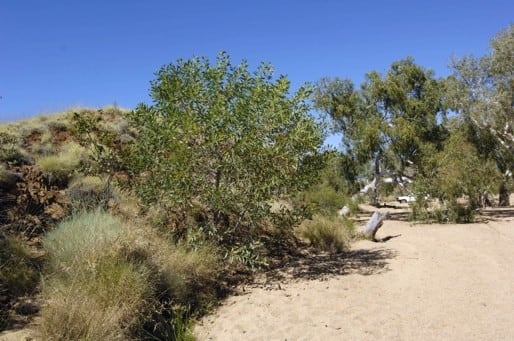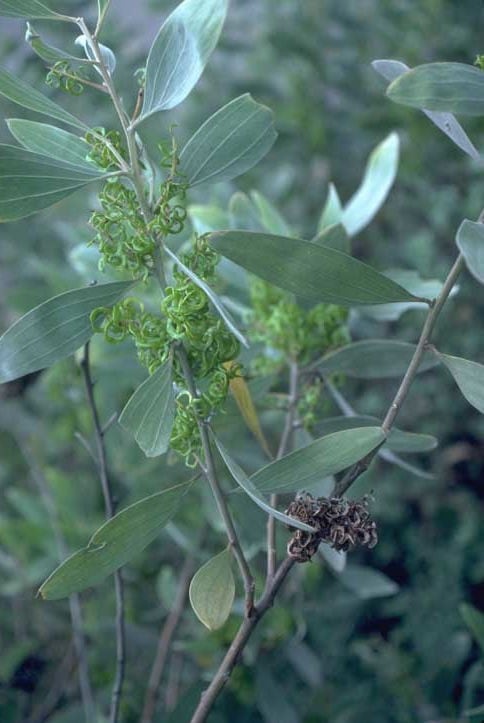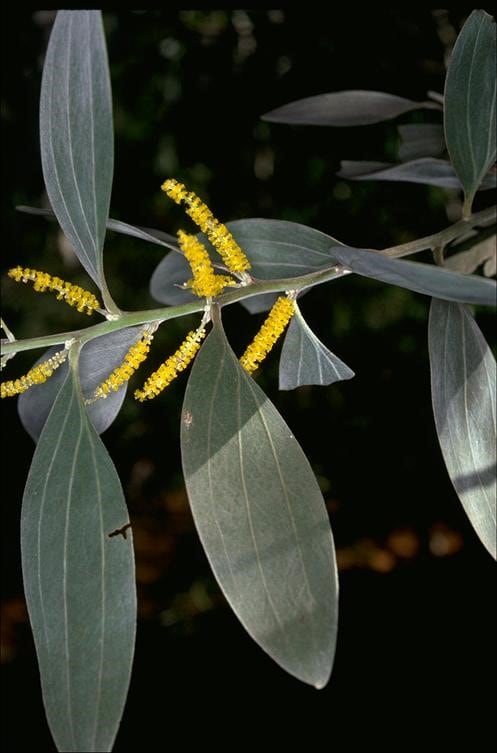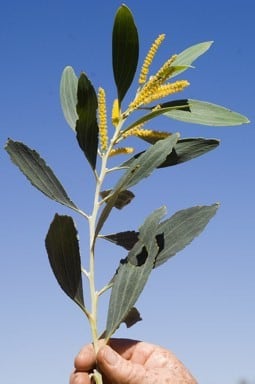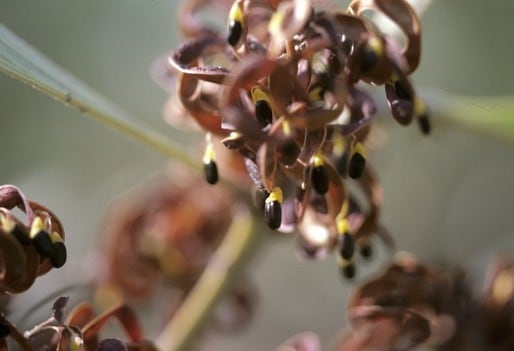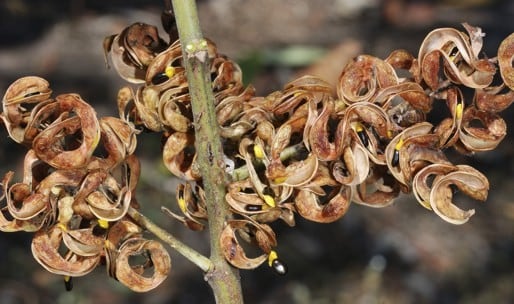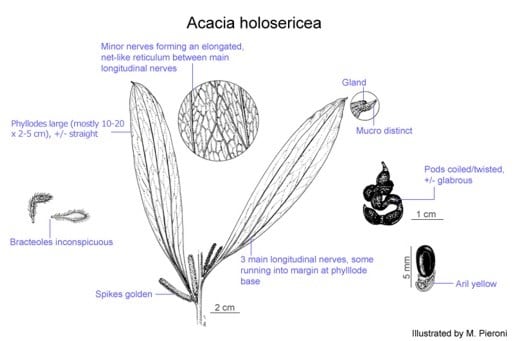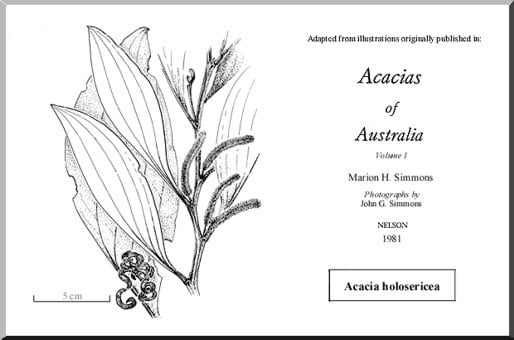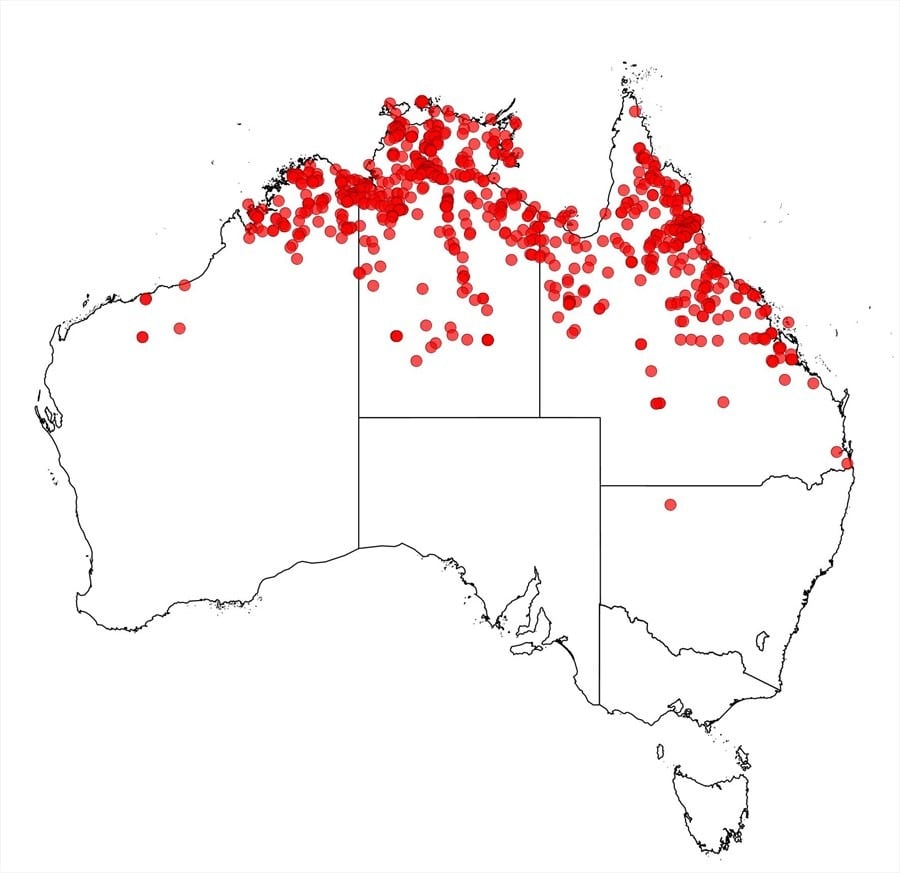Acacia holosericea A.Cunn. ex G.Don
WATTLE
Acacias of Australia
Common Name
Candelabra Wattle, Soap Bush, Silver Wattle, Silver-leaved Wattle
Family
Fabaceae
Distribution
Widespread in northern Australia extending from near Derby, W.A., E across the N.T. to near Rockhampton in eastern Qld. Also scattered occurrences in arid regions at Hamersley Ra. Natl Park, W.A., through central N.T. and to SW of Blackall, Qld.
Description
Shrub or tree 3–9 m high. Branchlets acutely angled but normally ±terete by 20–30 cm below apex, usually sericeous, sometimes glabrous. Young shoots silvery sericeous, sometimes glabrous. Phyllodes obliquely narrowly elliptic, 10–20 (–25) cm long, (1.5–) 2–5 (–6) cm wide, straight (not shallowly recurved at apices), silvery dull green or sub-glaucous, usually sericeous, with unequal base; mucro 1–3 mm long; with normally 3 prominent longitudinal nerves, 2 of which are basally confluent and sometimes contiguous with the lower margin of the phyllode, the minor veins forming a somewhat open, longitudinally orientated reticulum; glands basal and at base of mucro on at least some phyllodes. Inflorescences rudimentary racemes with axes to 0.5 mm long; peduncles 3–7 mm long, sericeous, sometimes glabrous; spikes normally 2–4 cm long, golden; bracteoles linear-spathulate, 1–1.5 mm long. Flowers 5-merous; sepals united; petals usually sericeous. Pods tightly and often somewhat irregularly coiled, 2.5–4 mm wide, thinly crustaceous to coriaceous-crustaceous, ±glabrous, remaining as entangled clumps following dehiscence. Seeds longitudinal, oblong-elliptic, 3.5 mm long, shiny, dark brown; aril bright yellow.
Phenology
Flowers Apr.–Oct.
Habitat
Grows in sometimes gravelly sand or loam, commonly forming communities along watercourses.
Specimens
W.A.: Barker R., 2.5 km S of Mt Hart HS, D.J.Edinger 455 (BRI, DNA, PERTH); Hancock Gorge, Hamersley Ra. Natl Park, M.E.Trudgen 1370 (BRI, PERTH). N.T.: Mini Mini Ck, 22 km WSW of Murgenella Settlement, J.H.Ross 3331 (MEL n.v. PERTH); Mt Ultim, Dulcie Ra., B.G.Thomson 2182 (DNA). Qld: Budgerygar, SW of Yaraka, C.F.Puttock AQ421303 (BRI).
Notes
Acacia holosericea is a fast-growing, short-lived species that has poor coppicing ability; the wood makes an excellent fuel but unlike its close relative A. colei, A. holosericea has limited potential for the production of human food. The phyllodes, bark and pods are used traditionally by N.T. Aborigines for pruritic skin conditions, headache and tropical infection, fide Aboriginal Communities of the Northern Territory (1993), Traditional Aboriginal Medicines N. Territory Australia 16–19 (Conservation Commission of the Northern Territory of Australia, Darwin) and as a bush soap, fish poison and for making spear shafts.
Branchlets, phyllodes and petals are sometimes glabrous but more commonly they are sericeous with appressed or subappressed hairs. There appears to be a continuous gradation from densely hairy to glabrous individuals; both A. holosericea var. glabrata and var. multispirea were based on ±glabrous specimens, fide L.Pedley, Austrobaileya 1: 182 (1978). Only rarely are the branchlets pubescent with spreading hairs (e.g. Petford, Qld, N.Hall H83/63, PERTH). Further study is needed to assess the taxonomic significance of variation in indumentum within this species. Specimens with the widest phyllodes occur in the northern parts of Qld and the N.T. (e.g. Elco Is., J.R.Maconochie 2147, BRI, CANB, DNA, L) and may sometimes resemble A. neurocarpa, but they seem to be A. holosericea on account of their short, linear-spathulate bracteoles and their slender branchlets which, although apically angled, are soon terete. The phyllodes of A. colei often superficially resemble those of A. holosericea.
In the light of genetic studies by G.F.Moran et al. (1992), in A.House & C.Harwood (eds) Australian Dry-Zone Acacias for Human Food (CSIRO, Canberra), the taxonomic status of A. holosericea was reviewed by B.R.Maslin & L.A.J.Thomson, Austral. Syst. Bot. 5: 729–743 (1992). Consequently A. holosericea is now more narrowly defined, and A. neurocarpa and A. colei are now excluded from it (see the latter two species for further details). Some of the species related to these three include A. cowleana, A. elachantha, A. grandifolia, A. mangium, A. nesophila, A. pellita and A. sericoflora.
FOA Reference
Data derived from Flora of Australia Volumes 11A (2001), 11B (2001) and 12 (1998), products of ABRS, ©Commonwealth of Australia
Author
Edited by B.R.Maslin
B.R.Maslin
This identification key and fact sheets are available as a mobile application:
URL: https://apps.lucidcentral.org/wattle/
© Copyright 2018. All rights reserved.
